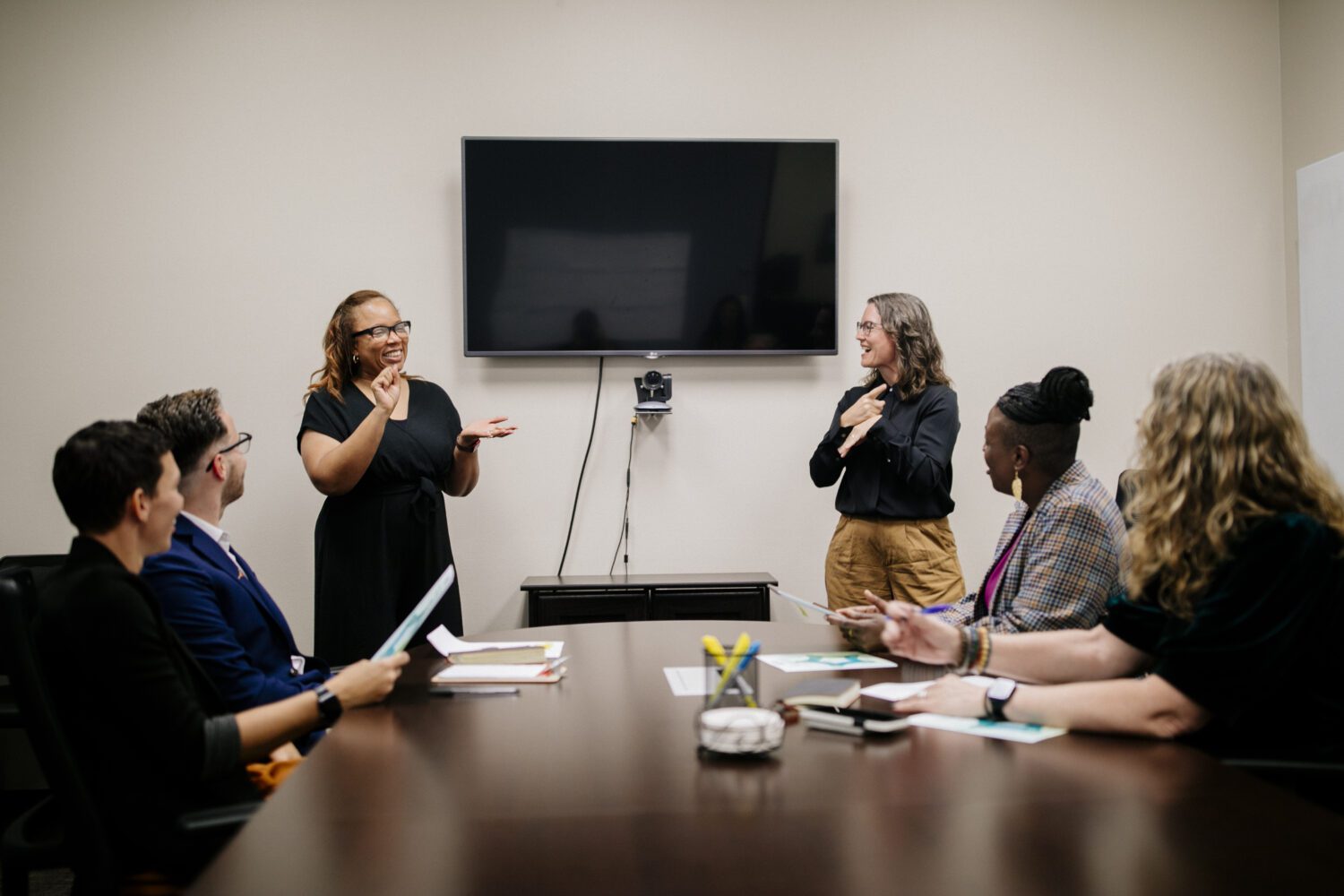Whether made of brightly-colored cotton or medical-grade materials, face masks are now a fact of life during the pandemic to help prevent the spread of COVID-19. But face masks can make communication difficult, especially for deaf students, faculty, and staff at your college — and it’s an issue that transcends the classroom.
The National Deaf Center on Postsecondary Outcomes (NDC) has identified the key communications concerns on campus regarding face masks, as well as strategies to overcome those barriers and ensure effective communications for all.
How Are Face Masks a Communications Barrier?
Face masks and personal protective equipment (PPE) can cause unintentional communication issues for everyone, across both spoken and signed languages.
-
They can muffle and distort audible speech. It is especially hard to hear someone speak through a face mask across a large, socially-distanced lecture hall or if there is any background noise.
-
They hide facial features and expressions essential for understanding context by anybody who is speaking or signing. In American Sign Language (ASL), facial expressions are so critical, they can affect the meaning of a sign. When face masks block necessary lipreading or visual cues, deaf people are not getting the full picture — even with a sign language interpreter in the classroom or office. That may cause increased stress, fatigue, and anxiety.
-
They inhibit those instant impressions that are so integral to our interpersonal communications. Want to be supportive with a simple, reassuring smile? Convey your displeasure with a frown? That’s blocked by your face mask, too.
What Does the CDC Recommend and the ADA Require?
The Centers for Disease Control (CDC) has released guidance for colleges and universities, as well as considerations for wearing face masks:
“Individuals who are deaf or hard of hearing — or those who care for or interact with a person who is hearing impaired — may be unable to wear cloth face coverings if they rely on lipreading to communicate. In this situation, consider using a clear face covering. If a clear face covering isn’t available, consider whether you can use written communication, use closed captioning, or decrease background noise to make communication possible while wearing a cloth face covering that blocks your lips.”
Regardless of your face covering or if your class is online or in person, the Americans with Disabilities Act (ADA) requires equitable access to education. The ADA’s Effective Communication document lays a foundation for consulting with a deaf individual, on a case-by-case basis, to identify communication needs.
Concerns About Face Masks on Campus
Hundreds of disability services professionals in higher education were polled by NDC about their top concerns with face masks on campus. More than one-third (37%) are concerned about determining appropriate accommodations when face masks or shields are a barrier. Nineteen percent are worried about campus requirements or policies, and 16% are concerned about addressing classroom acoustics and audio equipment needed for mask wearers.
However, the experts emphasized that accommodating face masks is not their ultimate goal — ensuring effective communication is, in all aspects of school and campus life for deaf students.
Are Clear Face Masks the Answer?
They can be. Face masks with clear panels to see the mouth and lower half of the face are highly sought-after as a remedy to the most common communications barriers. Many disability service professionals think they can be part of an overall access strategy, especially if they can be the standard mask option for everyone on campus. Others worry about availability and cost for buying clear face masks in bulk.
NDC has addressed several frequently asked clear mask questions, including:
-
Can I make my own clear face mask or shield? Finding and buying clear face masks and shields can be a challenge, and some people are making their own. First, check with your employer or school on whether homemade masks meet their health and safety rules, plus review the CDC standards on cloth face coverings. This is a comprehensive list of tutorials and DIY instructions for creating clear face masks. Some institutions are also using 3D printers to make face shields. Consider providing face masks or shields for service providers for use when working face to face with students.
-
Where can I find vendors for clear face masks and face shields? The website Knowledge Base maintains a list of clear mask and face shield vendors. Due to high demand, contact vendors directly for more information. NDC cannot recommend a specific vendor, although the NDC listserv has frequent exchanges with its subscribers about which vendors other colleges and universities are using.
-
How can I keep a clear face mask or shield from fogging up? One of the concerns about clear face masks is that some tend to fog up. The Hearing Spot and Knowledge Base provide several tips for care and use of clear masks.
Tips to Ensure Effective Communication
Face masks can help prevent the spread of COVID-19, but they don’t have to prevent effective communication with your deaf students. Use these tips and strategies to overcome the most common barriers.
-
Ask what a student prefers. Remember that each deaf student varies in their communication and accommodation needs. To help determine appropriate face masks or alternative accommodations, engage in an interactive process with your student using this checklist to identify their preferences. Work on how face-to-face communication can be supplemented with assistive listening systems, remote services, real-time speech-to-text services, or other accommodations. Most importantly: Let the deaf person lead the discussion and ensure they are comfortable with any decisions.
-
Consider remote services, even when the instruction is face-to-face. For instance, if an ASL interpreter will be required to wear a face mask or PPE for your face-to-face lab or class, work with the student and your institution to determine if remote interpreting services would be more effective.
-
Go beyond the classroom. Some deaf students use residual hearing and lip-reading to understand others, especially in non-classroom settings like tutoring or advising appointments, small group discussions, dorms, and while socializing. In these informal situations involving impromptu conversations while wearing face masks, consider using speech-to-text apps or automatic speech recognition (ASR) software. Though not 100% accurate, it can be helpful in brief conversations for real-time translation. Examples include AVA, Live Captioning, Live Transcribe, Microsoft Azure, and Otter.ai. Devices such as the UbiDuo, Pocketalker and Counter Loop can also be used in some informal situations.
Check out NDC’s COVID-19 information page for additional tips, resources, and guidance for colleges and universities in response to the pandemic.
Note: As a federally funded program, NDC does not endorse or recommend specific products, agencies, vendors, or other services.









